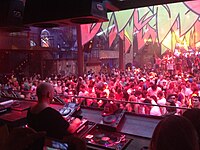
Photo from wikipedia
Abstract Introduction Medical problems are frequently encountered during electronic dance music (EDM) events. Problem There are uncertainties about the frequencies and severity of intoxications with different types of recreational drugs:… Click to show full abstract
Abstract Introduction Medical problems are frequently encountered during electronic dance music (EDM) events. Problem There are uncertainties about the frequencies and severity of intoxications with different types of recreational drugs: ethanol, “classical” illicit party drugs, and new psychoactive substances (NPS). Methods Statistical data on the medical problems encountered during two editions of an indoor electronic dance event with around 30,000 attendants were retrieved from the Belgian Red Cross (Mechelen, Belgium) database. Data on drug use were prospectively collected from the patient (or a bystander), the clinical presentation, and/or toxicological screening. Results In the on-site medical station, 487 patients were treated (265 in 2013 and 222 in 2014). The most frequent reasons were trauma (n=171), headache (n=36), gastro-intestinal problems (n=44), and intoxication (n=160). Sixty-nine patients were transferred to a hospital, including 53 with severe drug-related symptoms. Analysis of blood samples from 106 intoxicated patients detected ethanol in 91.5%, 3,4-methylenedioxymethamphetamine (MDMA) in 34.0%, cannabis in 30.2%, cocaine in 7.5%, amphetamine in 2.8%, and gamma-hydroxybutyric acid (GHB) in 0.9% of patients (alone or in combination). In only six of the MDMA-positive cases, MDMA was the sole substance found. In 2014, the neuroleptic drug clozapine was found in three cases and ketamine in one. Additional analyses for NPS were performed in 20 cases. Only in one agitated patient, the psychedelic phenethylamines 25B-NBOMe and 25C-NBOMe were found. Conclusions At this particular event, recreational drug abuse necessitated on-site medical treatment in one out of 350 attendants and a hospital transfer in one out of 1,000. Ethanol remains the most frequently abused (legal) drug, yet classical illicit recreational drugs are also frequently (co-) ingested. The most worrying observation was high-risk poly-drug use, especially among MDMA users. Regarding NPS, the number of cases was low and the clinical presentations were rather mild. It should be stressed that these observations only apply to this particular event and cannot be generalized to other EDM events. CalleP, SundahlN, MaudensK, WilleSMR, Van SassenbroeckD, De GraeveK, GogaertS, De PaepeP, DevrieseD, ArnoG, BlanckaertP. Medical emergencies related to ethanol and illicit drugs at an annual, nocturnal, indoor, electronic dance music event. Prehosp Disaster Med. 2018;33(1):71–76.
Journal Title: Prehospital and Disaster Medicine
Year Published: 2017
Link to full text (if available)
Share on Social Media: Sign Up to like & get
recommendations!